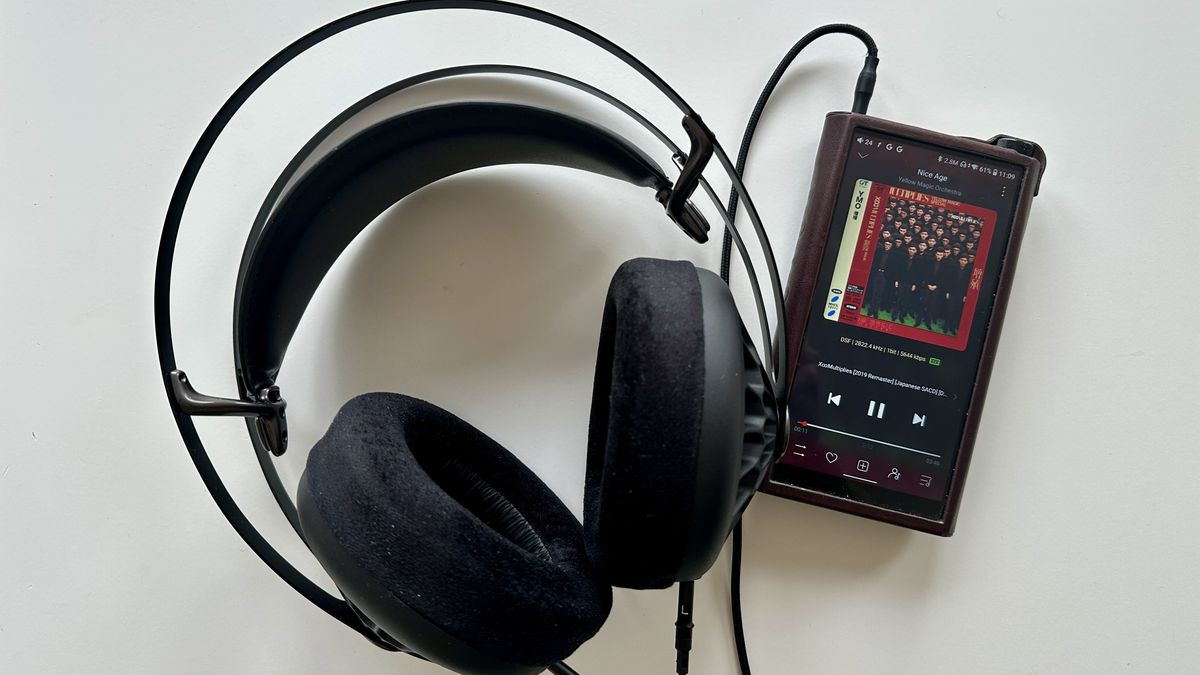Meze Audio 105 AER: Two-minute review
Meze Audio doesn’t just stick to the super-high end with its headphone designs – it just seems that way sometimes, because its super-high end headphones are so very good. Mind you, its idea of what constitutes ‘entry level’ won’t chime with everyone – these 105 AER open-backed, wired, over-ears are $399 / £369 / AU$799 a pair.
That money does buy a nicely designed, beautifully finished pair of headphones, though certainly they’re a notch or two up from the equivalent Grados, say, where perceived value is concerned. And while the lack of a balanced cable option is a bit stingy, there’s no arguing with the lengths Meze Audio has gone to where the dynamic drivers that do the audio business are concerned.
And in pretty much every respect, there’s no arguing with the way they sound either. In every meaningful respect, the 105 AER get the job done in fine style: they’re an easy listen in the most positive way. Detail levels are high, soundstaging is solid, dynamic headroom is considerable, low-end presence is impressive… you name it, the Meze Audio understand it. Some of the best wired headphones money can buy then? Oh certainly, if you’ll accept their open-backed nature.
If you’re in the market for wired, open-backed headphones – with all of the caveats those descriptions imply – and you have this sort of money to spend, it would be grossly negligent not to check the 105 AER out.
Meze Audio 105 AER review: Price & release date
- Released December 1, 2024
- Priced: $399 / £369 / AU$799
Meze Audio isn’t often seen in the sub $400 space – see the $1,999 / £1,799 / AU$3,399 Meze Audio Liric for reference, (now into their second iteration), however, the company has dipped its toes into more consumer-accessible pools recently, perhaps most notably with its $159 Alba in-ears.
At this price, Meze knows it could turn some heads – most pertinently from music lovers used to seeing such fees from Bose (whose QuietComfort Ultra cans are just a bit pricier) and Sony’s top-tier wireless designs. Will the bid win them over? It depends – wireless audio has, and will always have, its perks. But on audio quality alone, there really is no contest…
Meze Audio 105 AER review: Specs
| Type | Over-ear, open-back |
| Drivers | 50mm full-range dynamic |
| Weight | 336g |
| Cable length | 1.8m |
| Cable terminations | 3.5mm with 6.3mm adapter |
| Frequency response | 5Hz – 30kHz |
Meze Audio 105 AER review: Features
- 50mm full-range dynamic drivers
- 5Hz – 30kHz frequency response
- 112bB sensitivity, 42 ohms impedance
Just like every other pair of wired over-ear headphones, the Meze Audio 105 AER are not exactly overburdened with features. But just like every other pair of Meze Audio headphones I’ve tested, the 105 AER features are very thoroughly implemented.
Let’s be honest, though; when I talk about ‘features’, really I’m talking about the drivers that deliver sound to your ears. Everything else about the 105 AER is more correctly found in the ‘design’ section – so let’s talk about the drivers, shall we?
The ‘feature’ here is a 50mm full-range dynamic driver – or, more correctly, two of them. It’s closely based on the driver Meze Audio fits to its considerably more expensive models, with some minor adjustments to the frame and driver membrane to keep weight (and costs) down.
The ‘W’-shaped dome is made of a carbon-fibre/cellulose composite. Meze Audio prizes it for its durability and light weight, and reckons it rejects resonances more effectively than any alternative material. The torus – the ring that surrounds the dome – is made of semicrystalline polymer. It too is light and responsive, and its impressive damping characteristics keep vibrations and resonances to a minimum. Finally, there’s a copper/zinc alloy stabiliser around the outside of the membrane to further reduce distortion.
This arrangement results in a frequency response of 5Hz – 30kHz, manageable impedance of 42 ohms, and helpful 112dB sensitivity. So while the 105 AER are light on features, they are demonstrably fit for purpose.
Meze Audio 105 AER review: Sound quality
- Impressive powers of resolution
- Big, unified and poised sound
- Great insight and variation
One of the major benefits of the open-backed arrangement, in theory at least, is a spacious and open presentation of music. The Meze Audio 105 AER are one open-backed model that validate this theory.
A 2.8MHz DSD file of Radiohead’s Reckoner delivered by the 3.5mm output of a FiiO M15S digital audio player proves the point in some style. This is a complex, element-heavy recording that modulates through a number of dynamic variations, but throughout it the 105 AER maintain a big, well-defined and properly organised soundstage on which every individual element gets plenty of space in which to express itself. The resolution of the stage is straightforwardly impressive, and even though the Meze Audio offer plenty of separation they nonetheless present the record as a singular, unified whole. There’s a coherence to the way the song is delivered that makes it seem of a whole, like a performance.
Detail levels are high across the board. The 105 AER load on the information at every point, but are especially adept at offering lots of variation at the bottom of the frequency range. The top end is substantial and detailed, sure, and the midrange is articulate too… but where bass is concerned, the Meze Audio are able to offer a great deal of textural and tonal variety while still maintaining straight-edged control and ample weight.
The whole frequency range hangs together nicely, and there’s a smooth transition from top to bottom – the 105 AER play no favourites and transitions from lowest to highest frequencies evenly. The tonal balance is quite carefully neutral, which allows recordings to reveal their balance without the headphones sticking their oar in too obviously. So a 16bit/44.1kHz file of Aretha Franklin’s How I Got Over is as warm as an 18 tog duvet, while similarly sized file of Kraftwerk’s Europe Endless has just the right sort of austerity.
The Meze Audio handle the dynamics of harmonic variation with just as much confidence and positivity as they do the dynamic shifts in volume or intensity. They offer convincing rhythmic expression and a naturalistic way with tempo management. In fact, they have the sort of direct, unequivocal overall personality that makes every listen an event and makes every recording sound like it deserves your attention.
Meze Audio 105 AER review: Design
- 1.8m detachable cable with 3.5mm termination
- Self-adjusting headband
- Detachable velour earpads
I’ve previously described the design of some of Meze Audio’s pricier over-ear headphones as ‘overwrought’ – and at the time I thought I was being quite kind. So it’s nice to be able to report that having to keep costs down has resulted in a design that makes the 105 AER look coherent, quite elegant, and definitely no more than ‘wrought’.
The detachable ear pads are of velour-covered memory foam. They feel nice, sit comfortably without warming your head too quickly, and can easily be cleaned. The almost-semicircular outer headband that connects the two earcups is of slender stamped magnesium and the inner headband that’s the actual contact point is self-adjusting and made of PU leather. The outer part of the earcups is an interestingly organic design and made from ABS-PC thermoplastic. The result is Meze Audio’s lightest over-ear headphone to date – a very manageable 336g.
Each earcup needs wiring, and the 105 AER are supplied with a 1.8m length of braided cable that has the necessary pair of 3.5mm connections at one end and a single 3.5mm connection at the other. There’s also a 6.3mm adapter included. It’s a pity there’s no option of a balanced cable, but perhaps if we all pester Meze Audio then something might be forthcoming.
The 105 AER are supplied with a hard, zip-fastening travel case that’s a cut or two above the alternatives supplied by rival brands with their $399-ish over-ear headphones. A little pouch inside keeps your cable tangle-free when the headphones are not in use – and there’s enough room in there for a second cable, no problem. Just saying…
Meze Audio 105 AER review: Value
- Accomplished audio performance
- Convincing standard of build and finish
- Comfortable fit, coherent looks
It’s not even a question of ‘value’, really – but about the only way the Meze Audio 105 AER don’t make a strong-going-on-compelling case for themselves concerns the way they fit. Or, more correctly, the number of people they will fit – because although that headband is self-adjusting, it has upper and lower limits, and the lower limit isn’t all that low. In every other respect, though, it’s hard to make a justifiable complaint about the value that’s on offer here.
Should I buy the Meze Audio 105 AER?
| Section | Notes | Score |
|---|---|---|
| Features | As features within designs such as this go, there’s everything you’d possibly need | 5/5 |
| Sound quality | Insight; variation; poise; unification | 5/5 |
| Design | The only possible nit to pick here is the lack of 4.4mm cable | 5/5 |
| Value | Tiny issue: the headband. It’s very generous (possibly a tad too generous for smaller heads?) | 4.5/5 |
Buy them if…
Don’t buy them if…
Meze Audio 105 AER review: Also consider
| Header Cell – Column 0 | Meze Audio 105 AER | Sennheiser HD-660S2 | Grado Hemp |
|---|---|---|---|
| Price | $399 / £369 / AU$799 | $599 / £499 / AU$949 | $479 / £479 / AU$799 |
| Drivers | 50mm full-range dynamic (open-back) | 38mm (open-back) | 44mm Dynamic (open-back) |
| Weight | 336g | 260g | 218g |
| Cable length | 1.8m | Not stated | 1.77m |
| Connectivity | 3.5mm with 6.3mm adapter | 6.3mm, 4.4mm and 3.5mm cables | 3.5mm, 6.3mm |
| Frequency response | 5Hz – 30kHz | 8Hz – 41.5kHz | 13Hz – 28kHz |
How I tested the Meze Audio 105 AER
- Connected to an Apple MacBook Pro, a Naim Uniti Star and a FiiO M15S
- With a whole lot of different styles of music in a number of different formats
- Alone, because I’m not a barbarian
Because they’re open-backed, the 105 AER aren’t really candidates for mobile use. So all my listening took place either at my desk, connected to my laptop or to a digital audio player (the 4.4mm balanced output of which went sadly unused), or in my listening space connected to a Naim Uniti Streamer. At the desk, listening consisted of digital audio files of various types and sizes, while the connection to the Naim allowed for vinyl and CD content as well as network-attached stuff. And this happened, on and off, for well over a week…
Read the full article here















